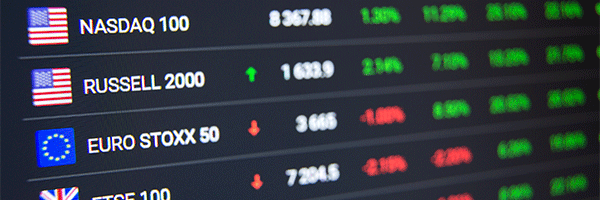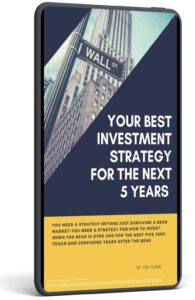Special Reports

July 30, 2021 | Daily JAM, Special Reports |
Long-term bucket pick #6: 10-year Treasuries. On first (and probably second and third) look, 10-year Treasures wouldn’t seem to have a place in my long-term bucket. After all how can they fix any income investing crisis? They are the income investing crisis. The yield on the 10-year Treasury was a meagre 1.22% on July 29. Retire on that! But yield is only one part of the return you can earn if you hold a Treasury bond to maturity–if interest rates fall.
July 30, 2021 | Daily JAM, DE, Long Term, Special Reports |
Long-term bucket pick #5: Deere (DE). Any stock that goes into a long-term bucket for a relatively conservative portfolio like this one, faces a tough test. You want the company to be tapped into some explosive long-term trend that will drive growth–but since this is a conservative portfolio you don’t want that trend to be totally or even mostly speculative.

July 30, 2021 | Daily JAM, Jubak Picks, Special Reports, V |
Long-term bucket pick #4: Visa (V). Think of Visa not as a credit card but as a network. We know from watching other networks–Amazon (AMZN) and Apple (AAPL), for example that a the more customers are plugged into a network, the more attractive that network is for merchants, and therefore the more convenient the network is for consumers. All this adds up to extraordinary profitability with operating margins of 65% in 2020

July 27, 2021 | Daily JAM, Special Reports |
Yesterday I started giving you specific picks so you can start to fill these buckets. I started with the short-term bucket, the most challenging of the three since it requires you to confront the current paucity of assets throwing off yields of even 2% head on. The goals for this bucket were maximum achievable safety since you don’t have much time in this bucket to recoup any temporary losses, a yield that’s as high as possible–anything over 3% these days is gravy. Remember that the higher the yield you can produce from this bucket, the less risk you’ll need to take in your portfolio, and predictable payments in actual cash (or cash equivalents). Remember that you want to be able to spend the returns from this bucket. Today I’m going to give you picks for filling out the third, the long-term, bucket.

July 26, 2021 | Daily JAM, Special Reports |
Today, I’m going to begin to give you specific picks so you can start to fill out the three buckets I recommended in Part 1 of this Special Report. Filling the long-term bucket is probably the most fun–who doesn’t like imagining the wealth that will roll in from finding the next Nvidia (NVDA) or from investing in the current Nvidia. The short-term bucket is the most challenging since it requires you to confront the current paucity of assets throwing off yields of even 2% head on.But let’s start there since the other buckets hang off the short-term bucket.

July 21, 2021 | Daily JAM, Long Term, Morning Briefing, Special Reports |
The big arguments in the financial markets these days are about inflation–will it stay elevated at an annual rate of the better than 5% reported in May and June or will be fall to the 2.5% or so envisioned by the Federal Reserve–and interest rates–the yield on the 10-year Treasury fell to 1.21% on Monday, July 19 and some market strategists see 1% in the cards while others are looking for a 2.5% or even 4% at the peak of this cycle. I certainly won’t pretend the results of these arguments don’t matter. Inflation sentiment and interest rate projections are the two biggest drivers of stock and bond prices right now. (Well, maybe in the short term next to worries that a fourth wave in the pandemic will shut down the U.S. and global economies again.) But these arguments matter rather less than you might think to investors saving for retirement and those looking to generate some income from their portfolio either to fund retirement or some other predictable big ticket item (like monthly mortgage payments on a first or second (don’t I wish) home.) That’s because from that perspective the results of these arguments don’t change the portfolio cash flow picture very much

June 27, 2021 | Daily JAM, Jubak Picks, Special Reports, Top 50 Stocks, You Might Have Missed |
The pandemic is over. (I’ve got my fingers crossed, I’ll admit, about a resurgence in the winter.) But it has left behind a changed world. The new normal won’t be exactly like the old normal in big and critical ways. For investors. Think of the pandemic as a really painful test for the global economy and individual companies. (As well as a global horror that killed more than 3 million people.) Some companies passed the test with flying colors–and in fact came out of the pandemic with stronger prospects than ever. Others saw the pandemic expose expected or unexpected weaknesses. In this Special Report I’ll be putting together a list of 5 picks and 5 pans for a Post-Pandemic economy.

June 21, 2021 | Daily JAM, Dividend Income, FCX, Jubak Picks, NVDA, SCCO, Short Term, Special Reports, Top 50 Stocks, Volatility |
After Wednesday’s news from the Federal Reserve, we all know that an interest rate increase is coming–even if we don’t know when. Could be 2022. Could be 2023. And even if we don’t know how many increases we’re looking for in that time period. Could be one. Could be two. The need to revise your portfolio to take that change in monetary policy is obvious. But figuring out how and when isn’t by any means straightforward. What gives? And how should be navigate a period that is almost certainly going to end with a reversal of the lower for longer interest rates that have dominated asset prices for decades? Today, for the last installment in my Special Report: “5 Picks and 5 Hedges for a Falling Market” I’m going to take one last run at how to hedge this market and how to position your portfolio for the developing trends. (I don’t have much hope that this will be the last time I’m visiting this topic, of course.)

June 8, 2021 | Daily JAM, Jubak Picks, Morning Briefing, Special Reports |
Before I get around to making the fifth and final stock pick in this Special Report: 5 picks and 5 Hedges for a Falling Market, let me take a moment to bring my survey of market conditions up to date. Where we are now has a strong influence on what stocks to own and buy and on how to hedge against any downturn. The question I’ve asked in the headline to this post is the critical one now: What happens when a momentum market loses its momentum? I think investors and traders can answer that question by just looking around them.

May 31, 2021 | Daily JAM, Mid Term, Morning Briefing, Special Reports |
Today’s installment includes one hedge (on the ViX) and one stock pick (Lam Research.) Now if you’ve been following along with the logic that I’ve laid out in this Special Report, you know that stocks face months of potential volatility around the Fed’s June 16 meeting (What will the Fed say about ending its $120 billion in monthly bond purchases?), the August global central bankers confab in Jackson Hole (Will the Fed use the occasion, as it has done in the past, to indicate a coming change in interest rate policy?), the Fed’s September 22 meeting (Will the Fed be content to say nothing with the next “important” meeting not until December?) and then the central bank’s December 15 meeting.) That’s a large number of occasions that could set the stock market to worrying again. And then, of course, there’s OPEC and the price of oil, the battle over the recently announced Biden budget, the continued logjam on infrastructure spending, and fact that the pandemic is still running at full speed in countries such as India (and who knows what the return of cold weather and forced winter “togetherness” will do to infection rates in the developed economies of the northern hemisphere.) At 16.74 on the VIX, you don’t need a panic to produce a profit on higher volatility. The VIX was at 22.18 on May 19. And then there are the even higher VIX levels of 27.59 on May 12, 28.57 on Marcy 4, and 28.89 on February 25.

May 25, 2021 | AMAT, Daily JAM, MGM, Mid Term, Morning Briefing, NXPI, Special Reports |
2021 will be a very different year from 2020. Or to be more exact the second half of 2021 and 2022 will be very different. We’re looking at going from a financial market where investors and traders believed the Federal Reserve was on their side with cash and more cash to push the prices of financial assets higher and then higher some more to a market where everyone is asking when will the Fed take th punch bowl away and shut down the party.Let me be clear. At this point it’s not the certainty that the Fed will reduce its $120 billion in monthly bond buying in this exact month or that, or the certainty that the Fed will start raising interest rates before the end of 2022, say, but rather the worry that those events are on the calendar, that they will change the trend in the market, and that no one can predict when the turn will materialize.FDR said “We have nothing to fear but fear itself.” To which the market right now says “Exactly.” Look at this “fear and worry calendar” that I’ve put together. And today I’ve got 3 picks and one hedge for this market

May 18, 2021 | CHPT, CLII, Daily JAM, DNNGY, ES, Jubak Picks, Morning Briefing, Special Reports, Volatility |
Here are my first five stock picks for my Special Report on finding “Real Green” Stocks. These are my “low-hanging fruit” stocks for climate change.














